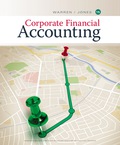
Corporate Financial Accounting
15th Edition
ISBN: 9781337670517
Author: WARREN
Publisher: Cengage
expand_more
expand_more
format_list_bulleted
Question
Chapter 14, Problem 14.1TIF
To determine
Internal Control: Internal control refers to the policies, and plans of the business organization along with other measures with a view to safeguard its assets, encourage the employees to adhere to the plans, to improve on the operational efficiency, and to ensure correct and reliable accounting information. Internal control is a process which ensures continuous reliability of accomplishment of a company’s objectives, related to operations, financial reporting, and in conformity with laws and regulations.
The following are the some of the internal control procedures:
- Competent personnel, rotating duties, and mandatory vacations
- Separating responsibilities for related operations
- Separating operations, custody of assets, and accounting
- Proofs and security measures
To determine: Whether J has been ethical in the behavior.
Expert Solution & Answer
Want to see the full answer?
Check out a sample textbook solution
Students have asked these similar questions
General accounting question
I am searching for the correct answer to this general accounting problem with proper accounting rules.
I want this financial accounting question answer
Chapter 14 Solutions
Corporate Financial Accounting
Ch. 14 - Briefly explain the difference between liquidity,...Ch. 14 - What is the advantage of using comparative...Ch. 14 - Prob. 3DQCh. 14 - How would the current and quick ratios of a...Ch. 14 - Prob. 5DQCh. 14 - What do the following data, taken from a...Ch. 14 - A. How does the rate earned on total assets differ...Ch. 14 - Kroger, a grocery store, recently had a...Ch. 14 - The dividend yield of Suburban Propane Partners,...Ch. 14 - Prob. 10DQ
Ch. 14 - Horizontal analysis The comparative accounts...Ch. 14 - Vertical analysis Income statement information for...Ch. 14 - Current position analysis The following items are...Ch. 14 - Accounts receivable analysis A company reports the...Ch. 14 - Inventory analysis A company reports the...Ch. 14 - Prob. 14.6BECh. 14 - To determine: Times interest earned ratio Given...Ch. 14 - Asset turnover A company reports the following:...Ch. 14 - Return on total assets A company reports the...Ch. 14 - Common stockholders profitability analysis A...Ch. 14 - Earnings per share and price-earnings ratio A...Ch. 14 - Vertical analysis of income statement Revenue and...Ch. 14 - a Current fiscal year income from continuing...Ch. 14 - Common-sized income statement Revenue and expense...Ch. 14 - Vertical analysis of balance sheet Balance shed...Ch. 14 - a. Net income increase, 78,0% Horizontal analysis...Ch. 14 - a. (1) Current year working capital. 1,090,000...Ch. 14 - Prob. 14.7EXCh. 14 - Current position analysis The bond indenture for...Ch. 14 - Accounts receivable analysis The following data...Ch. 14 - Accounts receivable analysis Xavier Stores Company...Ch. 14 - Inventory analysis The following data were...Ch. 14 - Inventory analysis QT, Inc. and Elppa Computers,...Ch. 14 - Ratio of liabilities to stockholders' equity and...Ch. 14 - Prob. 14.14EXCh. 14 - a. Mondelez International Inc., 1.4 Ratio of...Ch. 14 - a. YRC, 2.6 Asset turnover Three major segments of...Ch. 14 - Profitability ratios The following selected data...Ch. 14 - a. Year 3 return on total assets. 6.8%...Ch. 14 - Six measures of solvency or profitability The...Ch. 14 - Five measures of solvency or profitability The...Ch. 14 - Earnings per share, price-earnings ratio, dividend...Ch. 14 - a. Alphabet, 37.9 Price-earnings ratio; dividend...Ch. 14 - Earnings per share, discontinued operations The...Ch. 14 - Prob. 14.24EXCh. 14 - Unusual items Explain whether Colston Company...Ch. 14 - Comprehensive Income Anson Industries, Inc....Ch. 14 - Horizontal analysis of income statement For 20V2,...Ch. 14 - Prob. 14.2APRCh. 14 - Prob. 14.3APRCh. 14 - Measures of liquidity, solvency, and profitability...Ch. 14 - Solvency and profitability trend analysis Addai...Ch. 14 - Horizontal analysis of income statement For 20Y2,...Ch. 14 - Prob. 14.2BPRCh. 14 - Effect of transactions on current position...Ch. 14 - Measures of liquidity, solvency and profitability...Ch. 14 - Solvency and profitability trend analysis Crosby...Ch. 14 - Analyze and compare Amazon.com, Best Buy, and...Ch. 14 - Prob. 14.2MADCh. 14 - Analyze Deere Company Deere Company (DE)...Ch. 14 - Analyze and compare Marriott and Hyatt Marriott...Ch. 14 - Prob. 14.1TIFCh. 14 - Prob. 14.3TIF
Knowledge Booster
Similar questions
- Solve and show work.arrow_forwardSolve this without ai plarrow_forwardLast year, Parker Industries' cash account decreased by $22,000. Net cash provided by investing activities was $18,000, and net cash used in financing activities was $12,000. What was the net cash flow provided by (used in) operating activities on the statement of cash flows?arrow_forward
arrow_back_ios
SEE MORE QUESTIONS
arrow_forward_ios
Recommended textbooks for you
 Auditing: A Risk Based-Approach (MindTap Course L...AccountingISBN:9781337619455Author:Karla M Johnstone, Audrey A. Gramling, Larry E. RittenbergPublisher:Cengage Learning
Auditing: A Risk Based-Approach (MindTap Course L...AccountingISBN:9781337619455Author:Karla M Johnstone, Audrey A. Gramling, Larry E. RittenbergPublisher:Cengage Learning Auditing: A Risk Based-Approach to Conducting a Q...AccountingISBN:9781305080577Author:Karla M Johnstone, Audrey A. Gramling, Larry E. RittenbergPublisher:South-Western College PubPrinciples of Accounting Volume 1AccountingISBN:9781947172685Author:OpenStaxPublisher:OpenStax College
Auditing: A Risk Based-Approach to Conducting a Q...AccountingISBN:9781305080577Author:Karla M Johnstone, Audrey A. Gramling, Larry E. RittenbergPublisher:South-Western College PubPrinciples of Accounting Volume 1AccountingISBN:9781947172685Author:OpenStaxPublisher:OpenStax College

Auditing: A Risk Based-Approach (MindTap Course L...
Accounting
ISBN:9781337619455
Author:Karla M Johnstone, Audrey A. Gramling, Larry E. Rittenberg
Publisher:Cengage Learning

Auditing: A Risk Based-Approach to Conducting a Q...
Accounting
ISBN:9781305080577
Author:Karla M Johnstone, Audrey A. Gramling, Larry E. Rittenberg
Publisher:South-Western College Pub

Principles of Accounting Volume 1
Accounting
ISBN:9781947172685
Author:OpenStax
Publisher:OpenStax College